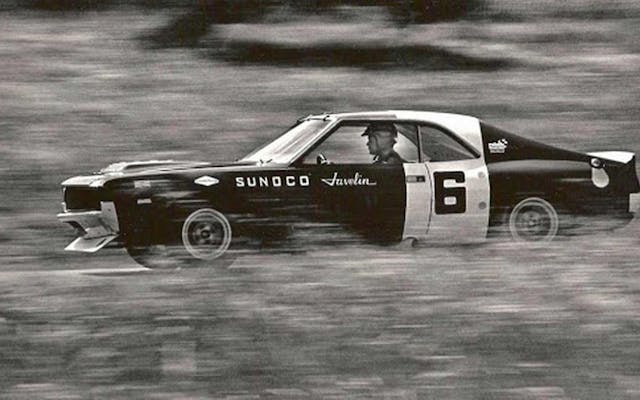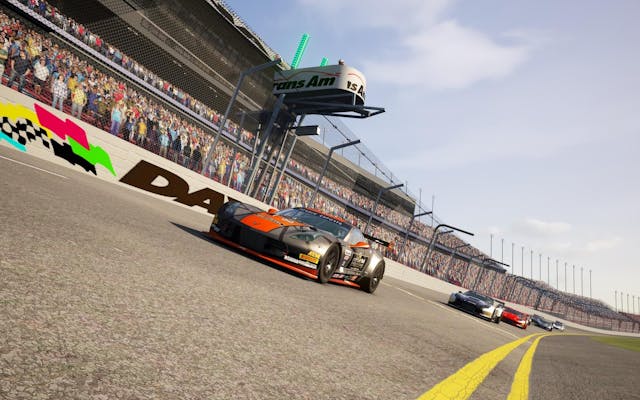Trans Am’s Esports Championship seeks to future-proof the legendary road racing series
Motorsports is about the evolution of culture as much as it is the mechanical technology under the hood. A series’ quest to stay relevant can be just as dramatic, and sometimes as tragic, as its drivers’ battle for the trophy or title. A racing series must navigate a field of challengers from all angles of the sport; the concerns of racers and fans may influence its trajectory as much as the interests of its sponsors and track owners. Few series understand this multifaceted struggle better than Trans Am, which is now working with Torque eSports to build a co-series based on Assetto Corsa, a racing sim.
The Trans Am series was formed in 1966 as the premiere showroom racing series in the U.S. and attracted contestants from nearly every American OEM alongside the likes of Porsche, Mini, Alfa Romeo, and even Jaguar. The two main classes were split based on engine displacement, with the iconic 305 cubic-inch displacement cap creating the mold for the high-revving Camaro Z/28 and Boss 302. In 1970, the elimination of the homologation rule birthed consumer versions of the AAR ’Cuda and Challenger T/A equipped with the six-barrel 340. As the series trudged through the Malaise Era with waning manufacturer support, it adopted tube chassis and silhouette bodies, abandoning factory-spec performance to satisfy tightening emissions and crash regulations.
Later, rules shifted to allow entries from other road racing series, which brought a fresh wave of interest to the series when Audi entered with its outrageous 200 Quattro—a turbocharged, all-wheel-drive terror that was effectively banned after winning its first season in 1988. The fact that the Quattro dominated all but one race may have factored into the series’ decision to ban overhead camshafts. Though the next 10 years, Trans Am spluttered along, its aging SCCA GT1-based tube-chassis cars falling farther and farther away from their production siblings, especially as carbureted V-8 muscle cars went extinct.
Between the end of 2006 and through 2008, there were no races; many figured that Trans Am was dead in the water. With the funding and leadership of two former racers, the series resumed in 2009, but with few changes to the recipe until the Trans Am Race Company was formed—which brings us to today. In the past decade, Trans Am has grown with the addition of several touring car classes, drawing entrants from other series, and a partnership with the Sportscar Vintage Racing Association (SVRA) to bring classic Trans Am metal to the race weekends.

Few challenges faced by the racing series have equaled that of COVID-19 and the ensuing wave of track closures as health officials worked to contain the pandemic. Without the chance to continue its momentum into 2020, the series had to find a way to keep all parties involved while tracks and engines stayed cold.
The Trans Am by Pirelli Esports Challenge reunites everyone within Assetto Corsa, a simulated racing platform that’s popular for its highly customizable nature, which gives Trans Am the ability to tweak the experience for their needs and integrate the tracks and cars they choose. “This allowed us to run tracks like Riverside International Raceway,” says John Clagget, Trans Am Race Co.’s president.
The southern Californian ghost track once wound through the rolling hills of Moreno Valley from 1957 through 1989, and it stood as a premier stop for road racing series of all varieties, even hosting the final race of the original Trans Am season. The virtual throwback race brought in the son of Trans Am legend Mark Donohue, David Donohue.
“Having an Esports series allows us to bring in guest drivers as TA Legends for events without having to start their own Trans Am team,” Clagget continues. Forget the 18-wheeler pulling a double-stacked hauler with cabinets stuffed full of expensive tools and spare parts; about the only requirement is a fast internet connection, a basic wheel-and-pedals setup, and a decent home computer.
“My dad had a great history at Riverside,” David Donohue told Trans Am. “I never got the chance to race there myself since my career started after it closed. However, on the sim, it has become one of my very favorites. It’s old-school in that it was built with a bulldozer and a vision, not on a computer. There are few turns relative to the length and a nice top speed. Today’s tracks seem to pack as much asphalt on the acreage as possible so you end up with a no-infield track that keeps looping back on itself. This track takes finesse and timing … and I’m going to get my clock cleaned!”
Perhaps he spoke too humbly; David finished 12th and 21st during the two heats at the digital Riverside Raceway, with the fresh faces of Cameron Lawerence, Ernie Francis Jr., Edward Sevadjian, and Tyler Kicera—drivers that range from just a few years younger to almost half his age. “In fact, what’s been interesting to see is that the TA2 drivers are doing so well,” Clagget added.
Alongside the “TA Legends” spots guest racers like David, Trans Am also introduced two sim-racing drivers under “TA Futures,” Dylan Archer and Cam Ebben, in a talent-scouting project. Eventually, Trans Am hopes to host sim-racing stations in which fans can enter Esports competitions and race against professional drivers and challenge both their live and virtual times.
Trans Am’s real race cars are split among four main classes, TA1 through TA4. TA1 is the keystone class, maintaining roots in the tube-chassis monsters born in the ’70s. These are brutally-effective at carving road course thanks to their barn-sized slicks, ex-NASCAR 358-cu-in powerplants, and ironing-board-sized rear wings, but the running costs of the program mean that entrants need substantial personal income or heavy sponsorship revenue. TA2 is the relatively low-budget alternative that utilizes several cost-controlled, spec parts—along with production-based engines—to keep a season from entering the seven-figure territory every year. TA3 and 4 are split up in order to power-balance entries from other road racing series, notably other stock-bodied GT-class racers.
“The Corvettes they’re racing with are the closest thing that Assetto Corsa has to our TA2 cars,” Claggett says. In the meantime, software developers are working with Trans Am to build a carbon digital copy of the series’ unique tube-chassis monsters so that the custom models used in the Esports championship feel as natural as possible to drivers while also showing the variety of near-factory body styles used.
Knowing that accessibility is the key to the future, Trans Am also launched its own mobile app, which brings live streaming and even complete race replays of both its live and Esports events—for free. As the industry endures one of its most trying times, Trans Am is using the challenge to reconsider how it reaches fans, engages drivers, and brings new talent through the ranks. Especially when looking at the past 15 years, it’s a stark leap in the right direction since Trans Am stalled in the mid-2000s. Claggett couldn’t say yet whether we’ll see a second season of Trans Am’s Esports championship, but the changes spurred by its inclusion in the 2020 season are bringing fresh interest to the stalwart series.
Trans Am will bring back live racing on June 26th to 28th at Mid-Ohio Sports Car Course, shortly after the Esports Championship ends on the 20th.


